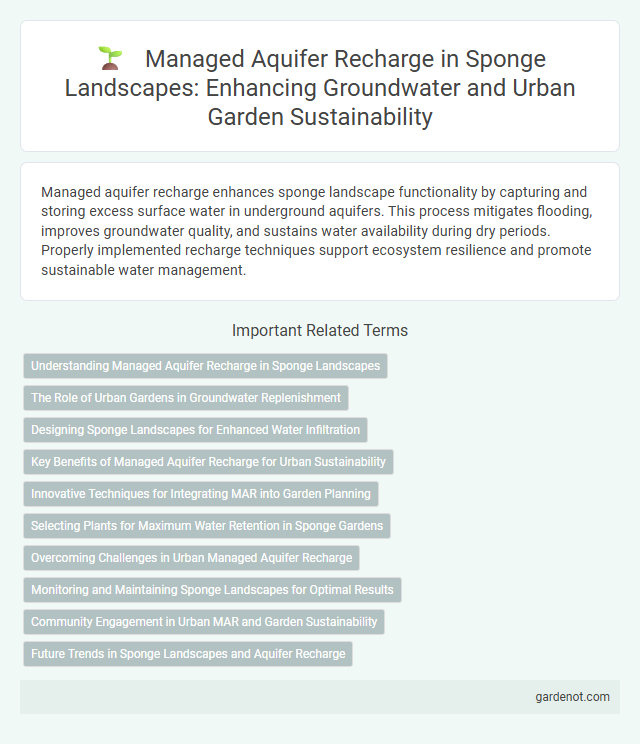Managed aquifer recharge enhances sponge landscape functionality by capturing and storing excess surface water in underground aquifers. This process mitigates flooding, improves groundwater quality, and sustains water availability during dry periods. Properly implemented recharge techniques support ecosystem resilience and promote sustainable water management.
Understanding Managed Aquifer Recharge in Sponge Landscapes
Managed Aquifer Recharge (MAR) in sponge landscapes enhances groundwater replenishment by leveraging natural soil permeability and vegetation cover to capture and store runoff efficiently. These landscapes act as porous systems, facilitating sustained infiltration and reducing surface water loss while minimizing flood risks. Understanding the hydrogeological characteristics and recharge capacity of sponge landscapes is critical for optimizing MAR implementation and ensuring water resource sustainability.
The Role of Urban Gardens in Groundwater Replenishment
Urban gardens play a crucial role in managed aquifer recharge by enhancing infiltration and reducing surface runoff, thus replenishing groundwater supplies effectively. Incorporating permeable soils and native vegetation in these green spaces improves water retention and supports the natural hydrological cycle. Studies show that widespread adoption of urban gardens can significantly mitigate urban water scarcity by increasing local groundwater recharge rates.
Designing Sponge Landscapes for Enhanced Water Infiltration
Designing sponge landscapes for enhanced water infiltration involves strategically integrating permeable surfaces, vegetation, and engineered recharge structures to maximize managed aquifer recharge (MAR). Key elements include bioswales, infiltration basins, and rain gardens that slow runoff, increase soil absorption, and facilitate groundwater replenishment. Optimizing soil texture and slope gradients within the landscape design significantly improves infiltration rates and overall MAR efficiency.
Key Benefits of Managed Aquifer Recharge for Urban Sustainability
Managed Aquifer Recharge (MAR) enhances urban sustainability by replenishing groundwater resources, reducing surface water runoff, and mitigating flood risks. It supports long-term water security for cities by increasing the availability of clean, stored water during dry periods. Integrating MAR within sponge landscape designs promotes resilience against climate change impacts and helps maintain ecological balance in urban environments.
Innovative Techniques for Integrating MAR into Garden Planning
Innovative techniques for integrating Managed Aquifer Recharge (MAR) into sponge landscape gardening include rainwater harvesting systems that channel excess water into infiltration basins or permeable garden soils. Use of bioswales and vegetated trenches enhances natural filtration while promoting groundwater recharge beneath urban gardens. Incorporating smart irrigation technologies and soil moisture sensors optimizes water distribution, ensuring efficient recharge without compromising plant health.
Selecting Plants for Maximum Water Retention in Sponge Gardens
Selecting native, deep-rooted plants such as sedges, rushes, and certain grasses enhances water infiltration and retention in sponge gardens by stabilizing soil and increasing organic matter. These plants facilitate managed aquifer recharge by slowing surface runoff and promoting groundwater replenishment. Incorporating drought-tolerant species ensures resilience during dry periods, maximizing the garden's efficiency in sustaining water storage.
Overcoming Challenges in Urban Managed Aquifer Recharge
Overcoming challenges in urban Managed Aquifer Recharge (MAR) requires innovative approaches to mitigate sediment clogging and contamination risks in highly developed areas. Utilizing permeable surfaces and engineered infiltration basins enhances groundwater recharge efficiency while ensuring water quality compliance. Integrating real-time monitoring systems supports sustainable aquifer management and optimizes recharge rates under dynamic urban conditions.
Monitoring and Maintaining Sponge Landscapes for Optimal Results
Effective monitoring and maintaining of sponge landscapes for Managed Aquifer Recharge (MAR) involves regular assessment of soil permeability, groundwater levels, and water quality to ensure optimal infiltration and storage rates. Employing remote sensing technologies and real-time data acquisition systems enhances the detection of clogging or contamination risks, facilitating timely interventions. Adaptive management practices based on continuous monitoring data support sustainable recharge capacity and long-term aquifer health.
Community Engagement in Urban MAR and Garden Sustainability
Community engagement in urban Managed Aquifer Recharge (MAR) projects enhances local stewardship and ensures sustainable water management practices by involving residents in planning and maintaining sponge landscapes. Urban MAR systems integrated with garden sustainability promote groundwater recharge through rainwater infiltration, supporting plant health and reducing urban runoff. Empowering communities with education and hands-on participation fosters long-term resilience of sponge landscapes in water-scarce urban environments.
Future Trends in Sponge Landscapes and Aquifer Recharge
Future trends in sponge landscapes emphasize integrating managed aquifer recharge (MAR) techniques with natural water retention systems to enhance groundwater resilience amidst climate variability. Advanced modeling and remote sensing technologies drive precise site selection and monitoring, optimizing recharge efficiency and sustainability. Innovations in bioengineered substrates and permeable urban infrastructure further support adaptive water management in urbanized sponge landscapes.
Managed aquifer recharge Infographic

 gardenot.com
gardenot.com